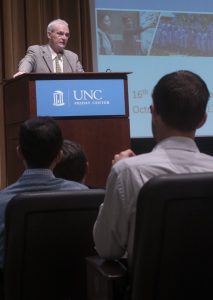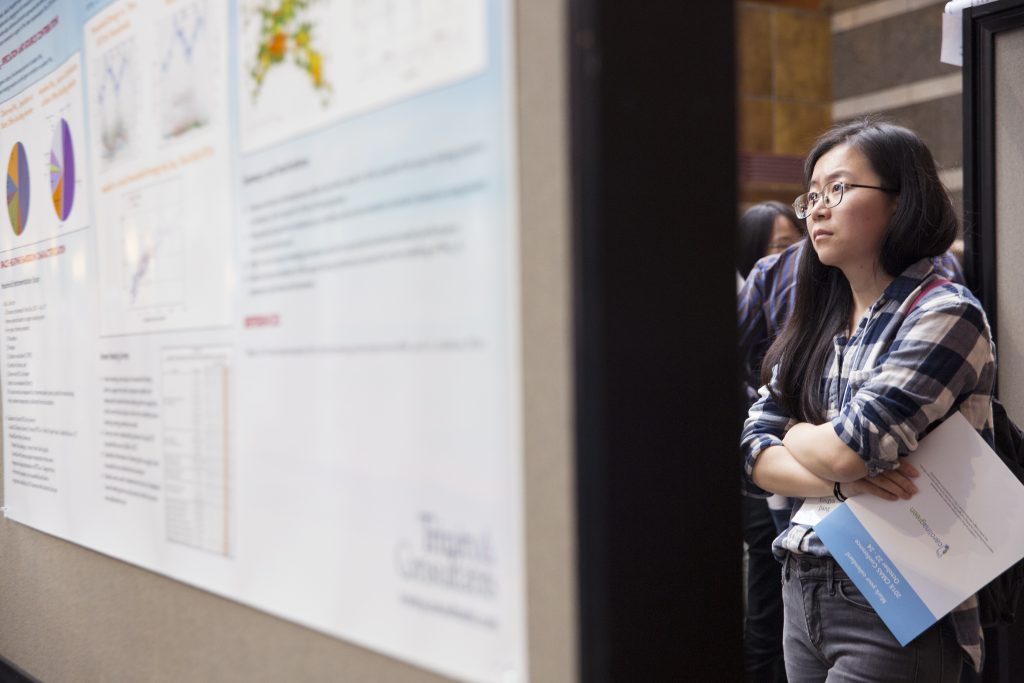Scientists explore new approaches to air quality modeling and health applications at 16th Annual CMAS Conference
November 2, 2017Highlights from the 2017 CMAS Conference
More than 260 air quality modeling scientists gathered Oct. 23-25 at UNC-Chapel Hill’s Friday Center for the 2017 Community Modeling and Analysis System (CMAS) Conference. The CMAS Center has been hosted by the UNC Institute for the Environment since its inception in 2002 through successive cooperative agreements and contracts with the U.S. Environmental Protection Agency (EPA).
This year marked the 16th installment of the event, which focuses on research, applications and policies related to air quality modeling and analyses and their impact on communities. The event is internationally recognized and is the premier gathering for air quality scientists to share research and ideas on the state of the science. Attendees included national and international air quality modelers, policy makers, academicians, federal and state governmental and non-governmental agencies, and various industries.
“The focus of this year’s conference was highlighted by 2 key sessions,” said Adel Hanna, a research professor and director of IE’s Center for Environmental Modeling for Policy Development and CMAS Center. “One was related to the nitrogen cycle and emissions in the atmosphere, which is an evolving subject and of concern to the whole community. The other presentation was on fine-scale modeling to start looking at streets and highways and related mobile emissions to the surrounding environment and surrounding communities. These presentations showed new approaches and how to integrate fine-scale and regional-scale when we do modeling.”
 UNC’s Vice Chancellor for Research Terry Magnuson welcomed attendees and thanked the EPA for giving UNC the opportunity to host CMAS over the years.
UNC’s Vice Chancellor for Research Terry Magnuson welcomed attendees and thanked the EPA for giving UNC the opportunity to host CMAS over the years.
“The university is tremendously proud of the CMAS team,” Magnuson said.
Hanna presented on the state of CMAS and pointed out the rise in international participants who travel to Chapel Hill for the conference each year. Thirty-five participants came from 16 countries outside of the United States.
Demand for meetings abroad is evidenced by CMAS’s expansion to South American and Asia. CMAS recently hosted the 3rd annual CMAS South America conference in August and will host CMAS Asia-Pacific in Beijing, China in May 2018.
Hanna also said CMAS membership was approaching 9,000 users world-wide.
Ali H. Omar, Langley Science directorate and acting head of the Atmospheric Composition Branch at NASA, discussed NASA’S satellite and sub-orbital measurements for air quality and health applications. Jimmy Fung, a professor of mathematics at Hong Kong University of Science and Technology, led a plenary session on fine scale street-level air quality informatics.
The three-day conference also featured themed sessions with multiple presenters covering various aspects of air quality modeling research, applications and policies.
A student poster competition was held throughout the conference and three winners were announced at lunch on the closing day. The CMAS External Advisory Committee, made up of 13 individuals from academia, international, federal and state governmental and non-governmental agencies, and various industries, judged and chose the winners:
- Minah Bae, Ajou University, South Korea: “Top-down Estimation of North Korean Emissions and their impacts on South Korean Air Quality”;
- Maria Paula Perez, University de Lod Andeas, Columbia: “Contribution of on-road mobile sources to SOA formation in Bogota: A sensitivity analysis coupling WRF-CHEM and the traffic model VISUM”;
- Eunhye Kim, Ajou University, South Korea: “Variation and Sensitivity of Regional Emissions Contributions to Particulate Matter Concentrations in the Seoul/Metropolitan Area, Korea.
The Community Modeling and Analysis System (CMAS) Center in the Institute for the Environment was established in cooperation with the U.S. Environmental Protection Agency to leverage the air quality community’s knowledge on air quality modeling and analyses in order to support community decision-makers in addressing air quality issues for the last 16 years.
In addition to this conference, the CMAS Center offers online training and support, air quality modeling software, data sharing, workshops, journal publications, and a visiting scientist programs. The Center’s training programs serve as an education and training core for those who need to learn about air quality, meteorological, and emissions models, and their uses. CMAS training programs reached more than 2,000 scientists in the past 16 years including training sessions in eight countries around the globe.
For more information on CMAS and to view a conference agenda, visit cmascenter.org.


